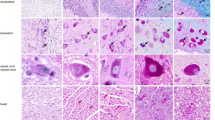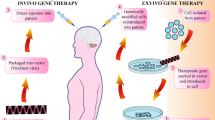Abstract
Summary: Most lysosomal storage diseases have central nervous system (CNS) involvement. No effective treatment is available at present. We investigated the usefulness of brain-directed gene therapy and cell therapy using mouse models of lysosomal storage diseases. For gene therapy to the CNS, a recombinant adenovirus encoding β-galactocerebrosidase gene was injected into the cerebral ventricle of neonatal twitcher mice, a murine model of Krabbe disease. Improvements in neurological symptoms and a prolonged lifespan were observed. Brain activity of β-galactocerebrosidase was increased significantly and the concentration of a cytotoxic metabolite, psychosine, was decreased. Pathological observations of the brain were also improved in treated twitcher mice. For cell therapy to the CNS, a neural stem cell line derived from human fetal brain was genetically engineered to overexpress β-glucuronidase and transplanted into the cerebral ventricles of neonatal MPS VII mice, a model of β-glucuronidase deficiency. Transplanted human neural stem cells were found to integrate and migrate in the host brain and to produce large amounts of β-glucuronidase. Brain contents of the substrate of β-glucuronidase were reduced and widespread clearing of lysosomal storage was observed in treated MPS VII mice. These data suggest that brain-directed gene/cell therapy may be useful in the treatment of neurological alterations in lysosomal storage diseases.
Similar content being viewed by others
REFERENCES
Birkenmeier EH, Davisson MT, Beamer WG, et al (1989) Murine mucopolysaccharidosis type VII. Characterization of a mouse with beta-glucuronidase deficiency. J Clin Invest 83: 1258–1266.
Meng XL, Shen JS, Ohashi T, Maeda H, Kim SU, Eto Y (2003) Brain transplantation of genetically engineered human neural stem cells globally corrects brain lesions in the mucopolysaccharidosis type VII mouse. J Neurosci Res 74: 266–277.
Shen JS, Watabe K, Ohashi T, Eto Y (2001) Intraventricular administration of recombinant adenovirus to neonatal twitcher mouse leads to clinicopathological improvements. Gene Ther 8: 1081–1087.
Suzuki K, Suzuki K (1995) The twitcher mouse: a model for Krabbe disease and for experimental therapies. Brain Pathology 5: 249–258.
Author information
Authors and Affiliations
Corresponding author
Rights and permissions
About this article
Cite this article
Eto, Y., Shen, J.S., Meng, X.L. et al. Treatment of lysosomal storage disorders: Cell therapy and gene therapy. J Inherit Metab Dis 27, 411–415 (2004). https://doi.org/10.1023/B:BOLI.0000031170.69676.68
Issue Date:
DOI: https://doi.org/10.1023/B:BOLI.0000031170.69676.68




